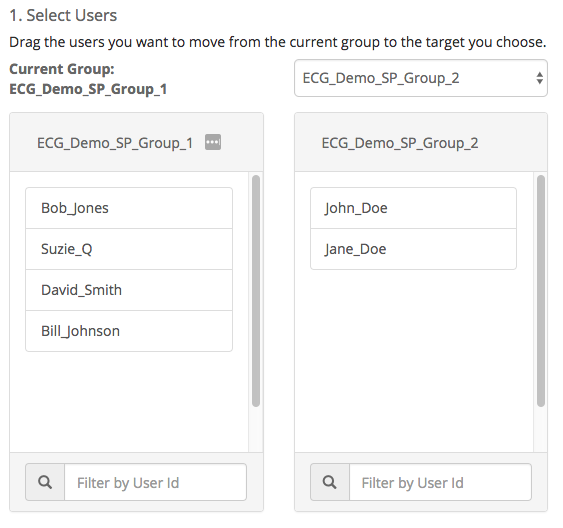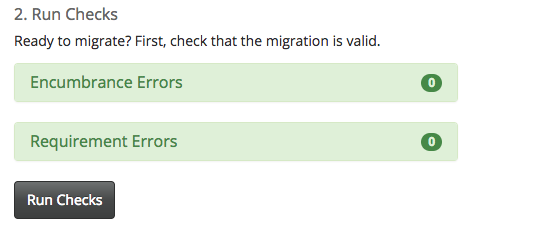User Collection Migration
The User Collection Migration location allows the simultaneous migration of multiple Users that may have some entanglements from one Group to another. An example would be Users with a shared device. In a regular User Migration if the User has a shared device then the migration would be encumbered. In a User Collection Migration we are able to move both Users as well as the device they share.
Process
Step 1
- The left panel represents the source Group and the right panel represents the destination Group.
- Choose a destination Group from the drop down above the right panel.
- The drag the Users you wish to migrate from the Source panel to the Destination panel.
- Use the filter box at the bottom of each panel to quick search for a particular User.
- Once all the Users you wish to migrate are in the Destination panel, move onto Step 2.

Step 2
- Once you are done arranging Users, click the Run Checks button to perform migration checks.
- The results of the checks will now be displayed. If no errors were found, the Encumbrance and Requirement panels will be green. If errors were found, the panels will be read and will display the errors.
- These checks must pass for the migration to be valid.

Step 3
- Once all checks have passed, the Migrate button will become available. When you are ready to migrate, click this button and the migration will begin.
- Once the migration has begun, it's status can be monitored in the Status Log panel located at the bottom of the page.
- The migration can also be monitored on the Tasks page. See Tasks Guide.

Procedure
User Collection Migration performs a sequence of information retrieval prior to migration to ensure that the Users meet the set of requirements and encumbrances that will allow them to successfully migrate from their current Group to another.
- Retrieve User(s) Information.
- Check Migration Validity.
- Remove Users from Group.
- Remove Devices from Group.
- Add Phone Numbers to Destination.
- Add Devices to Destination.
- Add Users to Destination.
- Assign Devices to Users.
- Add User Service Settings.
Recovery
Following the information retrieval process the full details of the Users are backed up for recovery purposes. The settings information retrieved is backed up as JSON. Announcement files and device configuration files are backed up in their original format. These files collectively can be used for recovery purposes.
Limitations
Encumbrances
Encumbrances are restrictions that are contained within the User's settings. These restrictions do not require a Destination Group to be determined and can be checked in advance for potential migration targets.
- Call Pickup Group Encumbrance - If a User is a member of a Call Pickup Group, the migration is encumbered.
- Meet Me Conferencing Encumbrance - If a User has a Meet Me Conferencing Bridge assigned, the migration is encumbered.
- Hunt Group Encumbrance - If a User is a member of a Hunt Group, the migration is encumbered.
- Group Calling Line ID Encumbrance - If a User has the same phone number as the Group Calling Line ID, the migration is encumbered.
- Enterprise Trunk Encumbrance - If a User is a member of an Enterprise Trunk, the migration is encumbered.
Requirements
Requirements are restrictions on migration that are determined by inspecting the desired Destination Group to determine if the Users can be moved into the Destination Group.
- Group User Limit Requirement - If the Group does not have enough User space available to accommodate the migration, the migration is not valid.
- Intra-Enterprise Inter-Group Requirement - The source and destination group must exist within the same Enterprise or Service Provider, otherwise the migration is not valid.
- Domain Requirement- The Domain (e.g., "xyz.com") that is applied to the User (at the Profile), and to the User's Identity/Device Profile Line/Port, must exist in the destination Group, otherwise the migration is not valid.
- Service and Service Pack Authorization Requirement - Services and Service Packs that the User is currently assigned must be available within the Destination Group.
- Group Schedules Requirement - The schedules contained within the User’s Source Group must also be contained within the User’s Destination Group, otherwise the migration is not valid.
- Group Extension Length Requirement - The Destination Group must have a valid extension length for the User, otherwise the migration is not valid.
- Group Extension Availability Requirement- The Destination Group must have a the current User extension available, otherwise the migration is not valid.